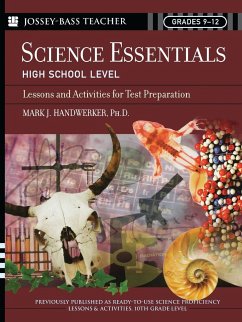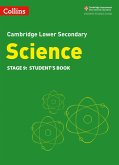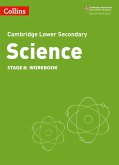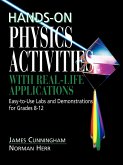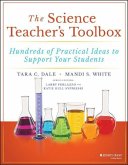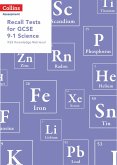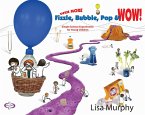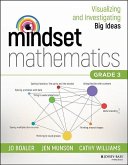Mark J. Handwerker (California Menifee)
Science Essentials, High School Level
Lessons and Activities for Test Preparation
Mark J. Handwerker (California Menifee)
Science Essentials, High School Level
Lessons and Activities for Test Preparation
- Broschiertes Buch
- Merkliste
- Auf die Merkliste
- Bewerten Bewerten
- Teilen
- Produkt teilen
- Produkterinnerung
- Produkterinnerung
Gives classroom teachers and science specialists a dynamic and progressive way to meet curriculum standards and competencies.
Andere Kunden interessierten sich auch für
![Collins Cambridge Lower Secondary Science - Lower Secondary Science Student's Book: Stage 9 Collins Cambridge Lower Secondary Science - Lower Secondary Science Student's Book: Stage 9]() Mark LevesleyCollins Cambridge Lower Secondary Science - Lower Secondary Science Student's Book: Stage 927,99 €
Mark LevesleyCollins Cambridge Lower Secondary Science - Lower Secondary Science Student's Book: Stage 927,99 €![Collins Cambridge Lower Secondary Science - Lower Secondary Science Workbook: Stage 8 Collins Cambridge Lower Secondary Science - Lower Secondary Science Workbook: Stage 8]() Collins GcseCollins Cambridge Lower Secondary Science - Lower Secondary Science Workbook: Stage 817,99 €
Collins GcseCollins Cambridge Lower Secondary Science - Lower Secondary Science Workbook: Stage 817,99 €![Hands-On Physics Activities with Real-Life Applications Hands-On Physics Activities with Real-Life Applications]() James CunninghamHands-On Physics Activities with Real-Life Applications45,99 €
James CunninghamHands-On Physics Activities with Real-Life Applications45,99 €![The Science Teacher's Toolbox The Science Teacher's Toolbox]() Tara C. DaleThe Science Teacher's Toolbox35,99 €
Tara C. DaleThe Science Teacher's Toolbox35,99 €![Recall Tests for GCSE 9-1 Science Recall Tests for GCSE 9-1 Science]() Emily QuinnRecall Tests for GCSE 9-1 Science155,99 €
Emily QuinnRecall Tests for GCSE 9-1 Science155,99 €![Even More Fizzle, Bubble, Pop & Wow! Even More Fizzle, Bubble, Pop & Wow!]() Lisa MurphyEven More Fizzle, Bubble, Pop & Wow!21,99 €
Lisa MurphyEven More Fizzle, Bubble, Pop & Wow!21,99 €![Mindset Mathematics: Visualizing and Investigating Big Ideas, Grade 3 Mindset Mathematics: Visualizing and Investigating Big Ideas, Grade 3]() Jo BoalerMindset Mathematics: Visualizing and Investigating Big Ideas, Grade 324,99 €
Jo BoalerMindset Mathematics: Visualizing and Investigating Big Ideas, Grade 324,99 €-
-
-
Gives classroom teachers and science specialists a dynamic and progressive way to meet curriculum standards and competencies.
Hinweis: Dieser Artikel kann nur an eine deutsche Lieferadresse ausgeliefert werden.
Hinweis: Dieser Artikel kann nur an eine deutsche Lieferadresse ausgeliefert werden.
Produktdetails
- Produktdetails
- Verlag: John Wiley & Sons Inc
- Seitenzahl: 393
- Erscheinungstermin: 8. Dezember 2004
- Englisch
- Abmessung: 280mm x 210mm x 22mm
- Gewicht: 1026g
- ISBN-13: 9780787975753
- ISBN-10: 0787975753
- Artikelnr.: 21790277
- Herstellerkennzeichnung
- Libri GmbH
- Europaallee 1
- 36244 Bad Hersfeld
- 06621 890
- Verlag: John Wiley & Sons Inc
- Seitenzahl: 393
- Erscheinungstermin: 8. Dezember 2004
- Englisch
- Abmessung: 280mm x 210mm x 22mm
- Gewicht: 1026g
- ISBN-13: 9780787975753
- ISBN-10: 0787975753
- Artikelnr.: 21790277
- Herstellerkennzeichnung
- Libri GmbH
- Europaallee 1
- 36244 Bad Hersfeld
- 06621 890
Mark J. Handwerker, Ph.D. has taught science in the Los Angeles and Temecula Valley Unified School Districts. As a mentor and instructional support teacher, he has also trained scores of new teachers in the "art" of teaching science. Dr. Handwerker is the author/editor of articles in several scientific fields and the coauthor of an earth science textbook currently in use.
About This Science TestPrep Teaching Resource v
I. BIOLOGY 1
Lessons 1 through 60 4 - 200
Basic Principles, Science Competencies, Reproducibles.
Chemical Reactions in Specialized Cell Organelles.
Cell Reproduction: Mitosis.
Genetic Variation in a Population: Mutation and Sexual Reproduction.
Development of Multicellular Organisms: The Zygote.
Phenotype and Genotype.
Genes and DNA.
Stability in an Ecosystem.
Frequency of Alleles in Gene Pools.
Evolution: The Result of Genetic Changes in Changing Environments.
The Internal Environment of the Human Body: Homeostasis.
Combating Disease.
Biology Practice Test 203
II. CHEMISTRY 215
Lessons 61 through 107 218 - 362
Basic Principles, Science Competencies, Reproducibles.
The Periodic Table.
Biochemical, Chemical, and Physical Properties of Matter Result from
Ability of Atoms to Form Bonds Based on Electrostatic Forces Between
Electrons and Protons and Between Atoms and Molecule.
The Conservation of Atoms in Chemical Reactions, The Principle of
Conservation of Matter.
The Kinetic-Molecular Theory.
Acids, Bases, and Salts.
Solutions.
Energy: Exchange and Transformation.
Chemical Reaction Rates.
Chemical Equilibrium.
The Bonding Characteristics of Carbon.
Nuclear Processes: Radioactive Decay, Nuclear Fission, Nuclear Fusion.
The Periodic Table of Elements 365
Chemistry Practice Test 367
Appendix 381
Preparing Your Students for Standardized Proficiency Tests 381 - 393
I. BIOLOGY 1
Lessons 1 through 60 4 - 200
Basic Principles, Science Competencies, Reproducibles.
Chemical Reactions in Specialized Cell Organelles.
Cell Reproduction: Mitosis.
Genetic Variation in a Population: Mutation and Sexual Reproduction.
Development of Multicellular Organisms: The Zygote.
Phenotype and Genotype.
Genes and DNA.
Stability in an Ecosystem.
Frequency of Alleles in Gene Pools.
Evolution: The Result of Genetic Changes in Changing Environments.
The Internal Environment of the Human Body: Homeostasis.
Combating Disease.
Biology Practice Test 203
II. CHEMISTRY 215
Lessons 61 through 107 218 - 362
Basic Principles, Science Competencies, Reproducibles.
The Periodic Table.
Biochemical, Chemical, and Physical Properties of Matter Result from
Ability of Atoms to Form Bonds Based on Electrostatic Forces Between
Electrons and Protons and Between Atoms and Molecule.
The Conservation of Atoms in Chemical Reactions, The Principle of
Conservation of Matter.
The Kinetic-Molecular Theory.
Acids, Bases, and Salts.
Solutions.
Energy: Exchange and Transformation.
Chemical Reaction Rates.
Chemical Equilibrium.
The Bonding Characteristics of Carbon.
Nuclear Processes: Radioactive Decay, Nuclear Fission, Nuclear Fusion.
The Periodic Table of Elements 365
Chemistry Practice Test 367
Appendix 381
Preparing Your Students for Standardized Proficiency Tests 381 - 393
About This Science TestPrep Teaching Resource v
I. BIOLOGY 1
Lessons 1 through 60 4 - 200
Basic Principles, Science Competencies, Reproducibles.
Chemical Reactions in Specialized Cell Organelles.
Cell Reproduction: Mitosis.
Genetic Variation in a Population: Mutation and Sexual Reproduction.
Development of Multicellular Organisms: The Zygote.
Phenotype and Genotype.
Genes and DNA.
Stability in an Ecosystem.
Frequency of Alleles in Gene Pools.
Evolution: The Result of Genetic Changes in Changing Environments.
The Internal Environment of the Human Body: Homeostasis.
Combating Disease.
Biology Practice Test 203
II. CHEMISTRY 215
Lessons 61 through 107 218 - 362
Basic Principles, Science Competencies, Reproducibles.
The Periodic Table.
Biochemical, Chemical, and Physical Properties of Matter Result from
Ability of Atoms to Form Bonds Based on Electrostatic Forces Between
Electrons and Protons and Between Atoms and Molecule.
The Conservation of Atoms in Chemical Reactions, The Principle of
Conservation of Matter.
The Kinetic-Molecular Theory.
Acids, Bases, and Salts.
Solutions.
Energy: Exchange and Transformation.
Chemical Reaction Rates.
Chemical Equilibrium.
The Bonding Characteristics of Carbon.
Nuclear Processes: Radioactive Decay, Nuclear Fission, Nuclear Fusion.
The Periodic Table of Elements 365
Chemistry Practice Test 367
Appendix 381
Preparing Your Students for Standardized Proficiency Tests 381 - 393
I. BIOLOGY 1
Lessons 1 through 60 4 - 200
Basic Principles, Science Competencies, Reproducibles.
Chemical Reactions in Specialized Cell Organelles.
Cell Reproduction: Mitosis.
Genetic Variation in a Population: Mutation and Sexual Reproduction.
Development of Multicellular Organisms: The Zygote.
Phenotype and Genotype.
Genes and DNA.
Stability in an Ecosystem.
Frequency of Alleles in Gene Pools.
Evolution: The Result of Genetic Changes in Changing Environments.
The Internal Environment of the Human Body: Homeostasis.
Combating Disease.
Biology Practice Test 203
II. CHEMISTRY 215
Lessons 61 through 107 218 - 362
Basic Principles, Science Competencies, Reproducibles.
The Periodic Table.
Biochemical, Chemical, and Physical Properties of Matter Result from
Ability of Atoms to Form Bonds Based on Electrostatic Forces Between
Electrons and Protons and Between Atoms and Molecule.
The Conservation of Atoms in Chemical Reactions, The Principle of
Conservation of Matter.
The Kinetic-Molecular Theory.
Acids, Bases, and Salts.
Solutions.
Energy: Exchange and Transformation.
Chemical Reaction Rates.
Chemical Equilibrium.
The Bonding Characteristics of Carbon.
Nuclear Processes: Radioactive Decay, Nuclear Fission, Nuclear Fusion.
The Periodic Table of Elements 365
Chemistry Practice Test 367
Appendix 381
Preparing Your Students for Standardized Proficiency Tests 381 - 393

